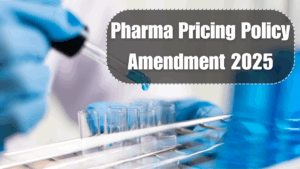The Pharma Pricing Policy Amendment 2025 has officially brought a new wave of price control and accessibility in India’s healthcare system. With updated price capping mechanisms and broader coverage of essential drugs, the National Pharmaceutical Pricing Authority (NPPA) has taken strong steps to regulate medicine costs in 2025.
This year’s amendment ensures more transparency and affordability, especially in the pricing of life-saving generic drugs, cancer medicines, and critical antibiotics. The Pharma Pricing Policy Amendment 2025 is already being implemented by manufacturers and distributors across the country.

Key Highlights of the 2025 Pharma Policy Changes
The Pharma Pricing Policy Amendment 2025 introduced several essential updates, making medicines more affordable and accessible for all income groups. These reforms are part of India’s larger mission to expand healthcare coverage and reduce out-of-pocket expenditure for patients.
Here are the major highlights:
-
NPPA expanded the National List of Essential Medicines (NLEM)
-
Over 450 new formulations brought under price control
-
Generic drugs given special pricing priority
-
Revised ceiling prices for anti-diabetic, cardiac, and oncology drugs
-
Price hike cap limited to 10% per annum on scheduled drugs
-
Price monitoring cells set up in every state
-
Manufacturers must report price revisions within 7 working days
The Pharma Pricing Policy Amendment 2025 is now seen as a model for equitable medicine pricing.
Impact on Patients, Pharmacies, and Manufacturers
With the enforcement of the Pharma Pricing Policy Amendment 2025, patients are already seeing noticeable price drops in commonly used medicines. Retail pharmacies now stock a wider range of low-cost generics, while pharmaceutical companies are adjusting production to match the new ceiling rates.
Who benefits:
-
Patients: More access to affordable treatment, especially for chronic diseases
-
Pharmacies: Higher turnover of essential drugs and fewer MRP disputes
-
Government: Better compliance with Right to Health goals
-
Manufacturers: Clarity on regulatory framework and fair competition
This shift empowers patients and supports India’s growing focus on universal healthcare backed by solid pricing policies.
Generic Drug Prices See the Biggest Drop in 2025
One of the biggest outcomes of the Pharma Pricing Policy Amendment 2025 is the pricing correction in the generic drug segment. Essential medicines like paracetamol, amoxicillin, metformin, and atorvastatin have seen significant price cuts, making treatment affordable for millions.
Comparison: Before vs After 2025 Amendment
| Drug Name | Avg. Price (2024) | Avg. Price (2025) |
|---|---|---|
| Paracetamol 500mg | ₹12 per strip | ₹6 per strip |
| Metformin 500mg | ₹20 per strip | ₹11 per strip |
| Amoxicillin 250mg | ₹28 per strip | ₹15 per strip |
| Atorvastatin 10mg | ₹35 per strip | ₹19 per strip |
This table shows how the Pharma Pricing Policy Amendment 2025 has significantly lowered costs across common formulations.
NPPA Monitoring and Compliance in 2025
The NPPA has now implemented real-time monitoring through its Integrated Pharmaceutical Database Management System (IPDMS 2.0). Manufacturers are required to update pricing and sales data periodically to ensure that the rules of the Pharma Pricing Policy Amendment 2025 are strictly followed.
Key monitoring features:
-
Price data submission every quarter
-
Random retail checks by NPPA teams
-
Fines up to ₹10 lakh for non-compliance
-
Direct complaint redressal system via NPPA app
-
Public access to updated drug price lists
This has created a stronger regulatory environment that supports ethical pricing.
FAQs
What is the Pharma Pricing Policy Amendment 2025?
It is a government-led pricing reform introduced in 2025 to control drug costs and expand the number of medicines under NPPA price regulation.
Has the price of all medicines dropped?
Not all, but over 450 essential formulations now have reduced ceiling prices under the Pharma Pricing Policy Amendment 2025.
Are generic drugs affected by this policy?
Yes. Generic medicines are a major focus, and their prices have been reduced significantly to make healthcare affordable.
What happens if companies don’t follow the price caps?
The NPPA can impose heavy penalties, including product recalls, fines, and even deregistration for repeated violations.
How can I check if a drug is under price control?
You can visit the NPPA website or use their official mobile app to view the updated list of price-controlled medicines.
Click here to know more.
